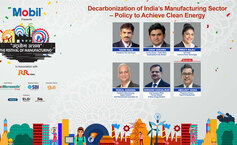
India has come a long way in the past decade. The economy has progressed to a position, where the world has recognised our potential and resilience. Last year, our economy emerged strong as the fifth largest, with growth forecast of 7 per cent - just 10 years ago, we were on the 11th place. If one looks back, there will be just a handful of instances that are as remarkable as India's growth story.
To say India's era has just begun is only befitting. We are set to be the second-largest economy by 2075, as forecasted in a report by Goldman Sachs. To get there, India needs to further revamp its manufacturing capacities and infrastructure, while continuing to boost the services sector. As we stand on the threshold of taking the next leap that will guide us towards Amrit Kaal 2047, India needs to put all its might into recognising manufacturing as the key differentiator, and a change maker for the economy.
This is the 10th anniversary of Make in India, a vision that has transformed our country's industrial landscape. Spearheaded by Prime Minister Shri Narendra Modi, this call-to-action has emerged as one of the strongest movements the world has seen in the recent past. What started as a seed to make India a global manufacturing hub, is now growing branches and leaves as we see businesses growing, industries revamping and economy transforming.
The manufacturing industry makes up to nearly 17 per cent of India's GDP and has become a defining factor for the country's economic growth, driven by strong performance of major sectors such as automotive, engineering, chemicals, pharmaceuticals, and consumer durables.
In the chemicals sector, the specialty chemicals segment has particularly witnessed a notable transformation under the Make in India initiative with the country emerging as a preferred manufacturing hub for domestic and export markets. The segment accounts for approximately 20 per cent of the total chemicals market, with key industries such as agrochemicals, pharmaceuticals, textiles, paper, paints, and soaps hinging on it.
The Indian specialty chemical segment is poised for a healthy growth, projected to touch $300 bn by FY25. The environment is conducive for chemical industry players to adapt and adopt to transform their businesses in line with the country's growth. Customer centricity needs to be at the core of operations through collaboration, differentiation, and resilience as it becomes a key driver for our economy.
The Make in India initiative has been ably supported by programmes such as Digital India, Startup India and World Solar Alliance. These programmes will be critical success factors in making our country a leading name in global as well as green supply chains. Driven by a wave of innovation fuelled by technological advancements, the manufacturing sector is moving towards an automated, standard, and process-driven era, which will better efficiency and productivity.
India is already an attractive destination for business from a captive market perspective and an enterprising young talent makes it a market that world wants to tap. With added emphasis on skill development, technological advancement and upgrading to world standards, India must further enhance its manufacturing capabilities.
Our country's journey of ascent gains significance, especially given the unpredictable geopolitical scenario. Despite risk predictions in the back of uncertainties such as the Russia-Ukraine war, strategic competition between the US and China, climate threats and energy security, India emerged as one of the world's leading economies, thanks to cost competitiveness and a broad manufacturing base. Strategies such as China Plus One, coupled with the government's acumen, are expected to further propel our growth in the coming decades.
The Indian economy stands poised at a juncture ripe with promise. Policies and programmes tailored to bolster the manufacturing sector are yielding commendable results. The Production Linked Incentive (PLI) scheme, reforms in tax regimes and liberalisation of the Foreign Direct Investment (FDI) policies in manufacturing have encouraged the business ecosystem in India. There has been a boost in local production, thanks to fostering of the spirit of self-reliance, thus reducing dependence on imports.
Atmanirbharta has always been India's backbone, and this was recently demonstrated by the decision to refrain from joining the world's largest trading bloc, Regional Comprehensive Economic Partnership (RCEP) in 2020, in a bid to protect the domestic market and curb trade deficits. The historic Comprehensive Economic Partnership Agreement (CEPA) of 2022 with the United Arab Emirates (UAE) will open access to Arab and African markets, boosting two-way trade to $100 billion in approximately five years.
Diplomatic partnerships such as the QUAD and I2U2, and trade agreements with Australia, Canada, European Union (EU) and African nations promise a bright future for Indian businesses. The G20 and Shanghai Cooperation Organisation (SCO) presidencies have made India one of the strongest voices in the Global South. These are major strides that will stand India in good stead as it progresses towards Amrit Kaal 2047.
Our mission to ‘Make in India and sell to the world' would mean a lot of preparation at several levels. The government will have to ensure more policies conducive to the nation's progress. At the same time, there has to be greater emphasis on skilling our people in a way that we have equipped workforce for every sector, particularly the manufacturing industry so that it is empowered in every way possible to flourish.
Going forward, India needs to leverage the potential of Industry 4.0 technologies offer. Also, the time is absolutely right for the manufacturing sector to boom and chart a path towards the nation's economic ascendancy. As we witness unprecedented digital transformation and agile technologies, it will be key to put our minds together and work out the best and most sustainable practices as eco-consciousness would hold the key to our future.
The present day shows us a great deal of hope of an economic renaissance, where growth will be inclusive and there will be a conducive environment to create and innovate. Consequently, there will be greater opportunities for employment and prosperity, thus creating a robust and holistic ecosystem for the nation. This can be achieved only if each of us fulfil our parts. The government, industry, and society, at large, will have to synergise efforts and work towards the unified vision of Amrit Kaal.


























